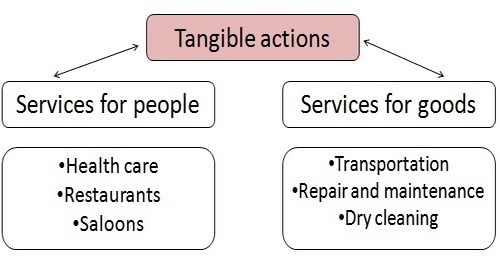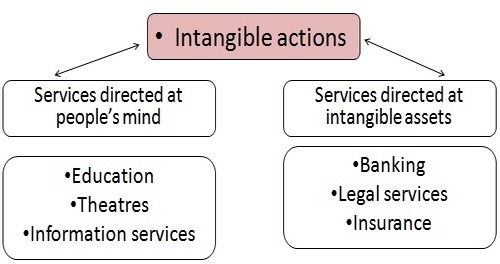In order to be able to make a clear and relevant classification of services, we would first need to understand the concept of the word itself. Services usually refer to processes and not physical products. To understand more, read this article on difference between goods and services. Some services may include people whereas other services (like online services) may including objects which are managed by people.
Examples of services which include people can be a hair salon, education, theater, restaurants, public transportation. On the other hand services that include objects include repairs and maintenance, dry cleaning, banking, legal services, insurance, etc.
The service processes can be either manual or mechanized or both.
It is possible to carry out a classification of services based on two general dimensions such as what is being processed, whether is it a person or an object, and how is it being processed? In other words, what is the nature of the process (tangible or intangible actions).
How can we further enhance our understanding of service classification?
One effective way to delve deeper into service classification is to examine recent successful campaigns that have strategically utilized these classifications. For instance, Starbucks recently implemented a new customer service strategy that focuses on personalized digital engagements, effectively blending tangible and intangible service elements. By leveraging its mobile app, the company provides customized offers based on customer preferences, bridging the gap between digital services and in-store experiences. According to a report by Business Insider, this approach led to a 4% increase in customer loyalty in 2022.
In addition, utilizing updated analysis tools can significantly enhance service offerings. Tools like ServiceNow and Zendesk offer comprehensive platforms for managing complex service processes by integrating AI to handle routine inquiries efficiently, allowing human resources to focus on personalized and intricate tasks. Gartner reports that companies employing these tools have seen a 30% boost in customer retention rates due to improved service management and reduced response times. Utilizing such tools not only enhances service delivery but also facilitates a better classification of services by distinguishing between customer-centered and object-centered engagements.
In terms of the people processing activities, the level of involvement of the people can vary significantly. Managers must think about processes/outputs in terms of what happens to customers and what is being created. For pricing this category of services, the non-financial costs, time mental effort as well as fear and pain level must be identified.
Having your computer broken and taking it to a repair facility is one example of service included in this category. Customers’ are less physically involved in this category of services and usually there is no real need for them to enter the service once he requested the service, explained the problem and pays the respective service.
Classification of services can be done on the basis of two points. These two points or factors, are further sub divided into 2 further variables. All in all, service classification considers four types of people or objects.
1) Classification of service based on tangible action
Wherever people or products are involved directly, the service classification can be done based on tangibility.
a) Services for people – Like Health care, restaurants and saloons, where the service is delivered by people to people.
b) Services for goods – Like transportation, repair and maintenance and others. Where services are given by people for objects or goods.
2) Classification of services based on intangibility
There are objects in this world which cannot be tangibly quantified. For example – the number of algorithms it takes to execute your banking order correctly, or the value of your life which is forecasted by insurance agents. These services are classified on the basis of intangibility.
a) Services directed at people’s mind – Services sold through influencing the creativity of humans are classified on the basis of intangibility.
b) Services directed at intangible assets – Banking, legal services, and insurance services are some of the services most difficult to price and quantify.
The most intangible form of service output is represented by information processing. The customer’s involvement in this type is service is not required. Generally, customers have a personal desire to meet face to face but there is no actual need in terms of the operational process. Consultancy services can be an example of this type of services where the relationship can be built or sustained on trust or telephone contact. However, it is more indicated to have a face-to-face relationship in order to fully understand the needs of the customer.
A more general classification of services based on the type of function that is provided through them can be as follows:
- Business services.
- Communication services.
- Construction and related engineering services.
- Distribution services.
- Educational services.
- Environmental services.
- Financial services.
- Health-related and social services.
- Tourism and travel-related services.
- Recreational, cultural, and sporting services.
- Transport services.
- Other services not included elsewhere.
As can be read, above were all the different ways to classify services
Liked this post? Check out the complete series on Services Marketing


Nice job indeed. Remain blessed.
Thank you Ekeke for the nice comment.
Thanks for the important information.keep up with the spirit. Be blessed
Thanx for da information.you are really great. stay blessed
why service classification?
the information is good
thank for the usful text.
about the sport services, could we say that the player or coach export and import is this classfication?
Good Job, Keep going, great hand of applause
thank you very much for the spirit
Well articles,these are very useful to who become young managers.Keep managing like this
What are three methods to classify services
please anyone give me three example “ service with accompanying goods“
and “goods with accompanying service“
i wiil be very thankfull
Can you explain why hotel is a people people processing, as the consumer use the service, it have a direct effect on consumer mind, as they feeling relax . The hotel business should allocate in mental stimulus.